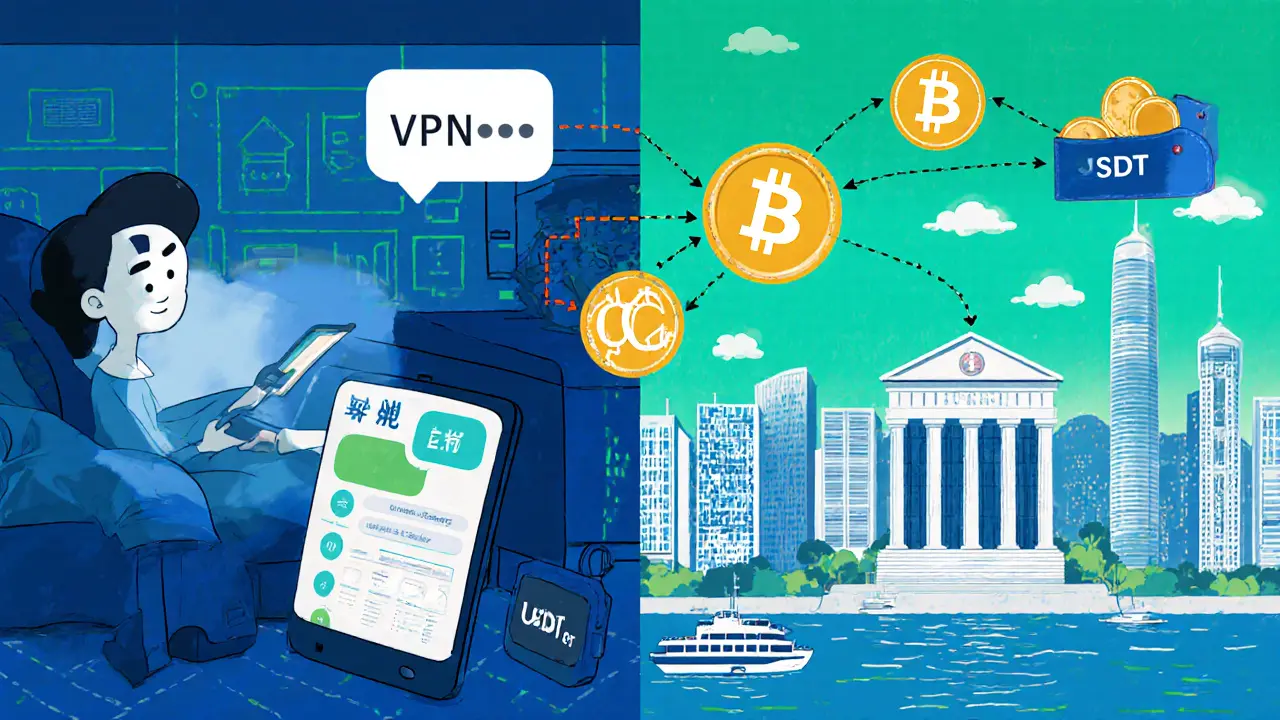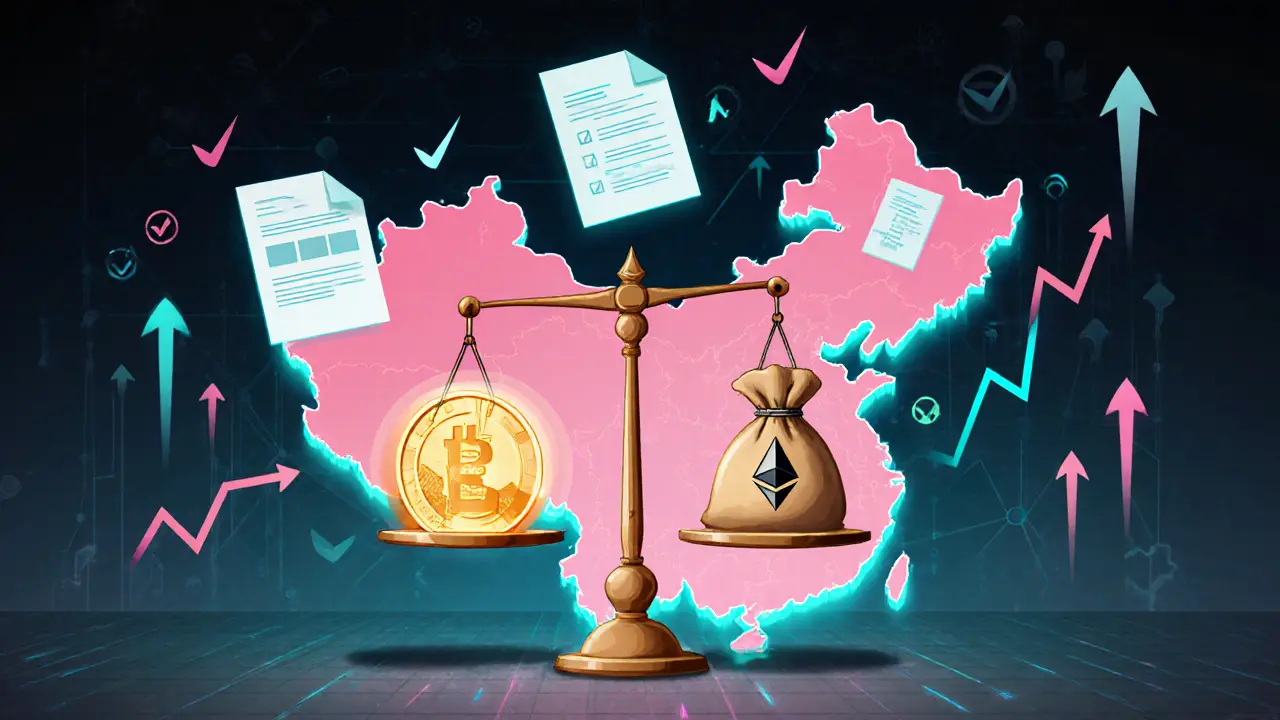Underground Crypto Trading in China - Risks, Scale & Reality

Underground Crypto Trading Risk Calculator
Enter Your Trading Details
Risk Assessment Results
When it comes to Underground Crypto Trading in China is the covert network of peer‑to‑peer, OTC and VPN‑enabled cryptocurrency transactions that operate despite the People's Bank of China's ban on digital asset trading, the scale is surprisingly massive.
What the underground market actually looks like
China's crackdown began in 2013, tightened in 2017, and culminated in a full ban in 2021. Yet, between July2022 and June2023, traders moved roughly $86.4billion worth of Bitcoin, Ethereum and other tokens. That volume eclipses HongKong’s legal market, which posted about $64billion in the same window.
According to Chainalysis, the underground ecosystem accounts for roughly 3% of China’s annual GDP, translating to a multi‑billion‑dollar impact on the country’s financial landscape.
Why traders keep going underground
The main driver is scarcity of attractive domestic assets. In 2023, the CSI300 index sank 35% over three years, and earnings forecasts missed expectations for a tenth straight quarter, according to MorganStanley. With limited upside in stocks and bonds, investors turn to crypto for higher returns and portfolio diversification.
Even though the state plans to inject about 2trillionyuan into equity markets, sentiment remains weak, cementing crypto’s appeal as a high‑risk, high‑reward alternative.
How the network operates under the radar
Traders rely on a blend of technology and cross‑border relationships:
- VPNs and private proxy chains to mask IP addresses and reach overseas exchanges.
- Peer‑to‑peer (P2P) platforms where buyers and sellers negotiate directly, often using WeChat or Telegram groups.
- Over‑the‑counter (OTC) brokers that provide escrow services, reputation scores and fiat settlement in Chinese yuan via HongKong bank accounts.
- Stablecoins (USDT, USDC) serve as a bridge, letting traders hold a dollar‑pegged asset while waiting for a safe yuan‑to‑crypto conversion.
- HongKong functions as a jurisdictional gateway; many mainland participants set up corporate entities or personal bank accounts there to move funds legally.
This multi‑layered approach makes enforcement costly and detection difficult.

Legal landscape - gray zones and recent twists
Officially, China bans all commercial crypto activities: exchanges, mining farms and institutional services are illegal. However, personal ownership of Bitcoin, Ethereum and other tokens remains technically permissible, a nuance reinforced by courts labeling crypto as “legal property” in 2025.
Conflicting reports surfaced in May2025 suggesting new limits on personal holdings, but the regulatory picture remains unsettled. Meanwhile, Shanghai regulators have started drafting stablecoin guidelines, hinting at a possible controlled re‑entry.
Risk assessment - what every participant should know
Operating in the underground market exposes traders to three broad risk categories:
| Risk Type | Underground Market | Regulated Market |
|---|---|---|
| Legal | Potential asset seizure, fines, criminal prosecution | Compliance‑based protection, clear legal recourse |
| Counterparty | High default risk, limited escrow, no consumer safeguards | Insurance, custodial guarantees, dispute resolution |
| Operational | VPN outages, platform shutdowns, forced migrations | Stable API access, 24/7 support, transparent SLAs |
Financial volatility is a given in any crypto market, but underground traders lack the safety nets that regulated exchanges provide, making losses potentially catastrophic.
Who is behind the transactions?
The market splits into three main segments:
- High‑net‑worth individuals - use HongKong‑based corporate structures, private banking, and professional OTC desks.
- Retail investors - rely on WeChat groups, small‑scale P2P brokers and single‑VPN setups.
- Professional traders - connect to offshore platforms that offer Chinese‑language support and yuan‑denominated pricing, often via sophisticated arbitrage bots.
Large retail trades (>$10k) make up nearly twice the global average, showing that many participants are seasoned investors rather than casual hobbyists.

Future outlook - will the underground market survive?
Two forces will shape the next chapter:
- Digital yuan (e‑CNY) - the state’s push for a sovereign CBDC aims to capture the demand that currently fuels crypto demand.
- Regulatory clarification - if China formalizes stablecoin rules or eases personal‑holding restrictions, some underground activity could migrate into a semi‑legal framework.
Even with tighter enforcement, the underlying incentives-limited domestic investment options and a desire for high‑yield assets-remain. Analysts from Kapronasia predict that the underground market will continue to exist, though its size may ebb and flow with enforcement intensity.
Key takeaways
- The underground crypto market in China moved over $86billion in a single year, dwarfing legal markets nearby.
- Traders use VPNs, P2P platforms, OTC brokers and HongKong banking links to bypass bans.
- Legal risks are severe-assets can be seized and participants prosecuted.
- Operational and counter‑party risks are higher than in regulated exchanges.
- Future policy shifts, especially around stablecoins and the digital yuan, could reshape but not erase the underground ecosystem.
Frequently Asked Questions
Is it legal to own Bitcoin in China?
Personal ownership of Bitcoin and other tokens is not expressly prohibited, but any activity that involves buying, selling or trading is illegal under current regulations.
How do Chinese traders move crypto to fiat?
Most use OTC brokers that settle in Chinese yuan via HongKong bank accounts. Some employ stablecoins as an intermediate step before converting to cash through local money‑transfer services.
What are the biggest risks of underground trading?
Legal prosecution, asset seizure, loss of funds due to counter‑party default, and technical failures of VPN or OTC platforms are the three primary hazards.
Can stablecoins be used safely in China?
Stablecoins are popular because they reduce exposure to crypto volatility, but they remain part of the underground chain and carry the same legal and counter‑party risks.
Will the digital yuan replace crypto demand?
The e‑CNY offers a state‑controlled digital payment option, yet many investors still seek the decentralized nature of crypto. Expect coexistence rather than outright replacement in the near term.

13 Comments
Wow, the sheer scale of underground crypto in China is mind‑blowing – it’s like a hidden neon city of traders hustling beneath the radar! The risk calculator vibe really helps us picture the danger zones.
The breakdown of legal, counter‑party and operational risks is spot‑on. Traders should especially watch VPN reliability – a single outage can freeze assets and attract unwanted attention.
Honestly, this whole underground scene feels like a Wild West movie, full of reckless gunslingers, endless loopholes, and a sheriff that never shows up, making every transaction a gamble.
China’s crypto ban fuels an illicit market that moves over $86 billion annually.
From a technical standpoint, the multi‑layer VPN stacks act like onion routing for finance, but each added layer also adds latency, which can turn a profitable arbitrage into a loss if the market shifts quickly.
i think ppl need 2 think twice before dive in, cause legal trouble is real and the whole thing can be super risky.
🚀 Let’s get real: the adrenaline rush of beating the system is real, but the crash when a VPN drops? Brutal. Keep your safety nets tight, fam! 🌐
Think of it as a chess game where every move is watched. Patience, discipline, and a solid support network can turn a risky play into a strategic win.
The allure of high‑yield crypto in a constrained market is understandable, yet the hidden cost is often ignored. When you factor in legal exposure, the risk‑adjusted returns shrink dramatically. It’s like buying a luxury car without insurance – the thrill is there, but a single accident can bankrupt you. Moreover, the reliance on offshore OTC desks introduces a trust deficit; many of these desks lack transparent audit trails, making it difficult to verify solvency. On the operational side, the volatility of VPN performance adds a stochastic layer to execution risk – you could be looking at a 20‑30% chance of a forced disconnect at any given moment. In practice, most successful operators build redundancy: multiple VPN providers, backup exit nodes, and diversified broker relationships. Still, the regulatory backdrop remains the dominant factor – a sudden crackdown can wipe out entire networks overnight, turning a thriving clandestine market into a ghost town. For anyone weighing entry, the calculus should include not just potential upside but also the magnitude of possible legal repercussions, which can range from asset seizure to criminal prosecution.
Honestly, most of these OTC platforms are just glorified middlemen with no real consumer protection – proceed with caution.
Great summary! If you’re diving in, always keep a backup plan – a secondary VPN, a trusted friend in Hong Kong, and never put more than you can afford to lose.
Everyone, remember that even a “low risk” label doesn’t erase the fact that the state can still seize assets. Stay humble and protect your keys.
In light of recent judicial pronouncements, it is incumbent upon participants to meticulously assess the legal ramifications of any transaction, notwithstanding the ostensible permissibility of personal ownership.